#Alexander II
Text

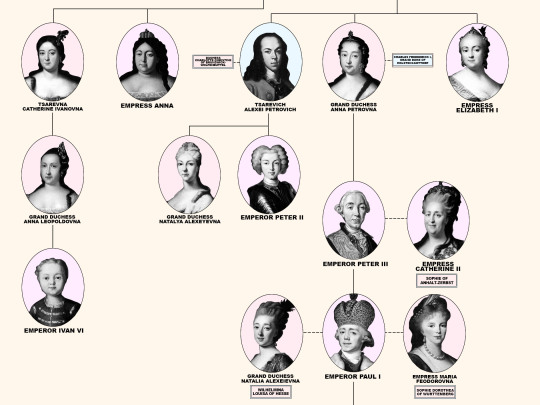
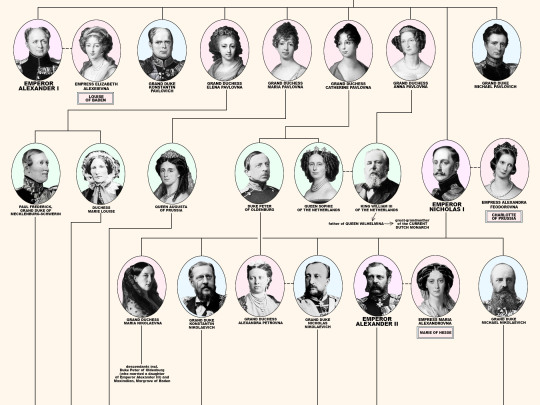
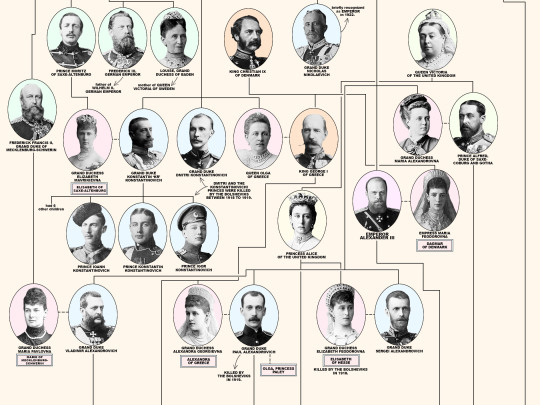

Members of the House of Romanov, the last reigning Dynasty of Russia.
From the first Romanov Russian Tsar Michael I (reigned 1613-1645) until the last Emperor Nicholas II (reigned 1894-1917). Including the 18 members of the house executed from 1918 until 1919; Grand Duke Michael Alexandrovich (13 June 1918). Nicholas II, Empress Alexandra Feodorovna, Grand Duchesses Olga Nikolaevna, Tatiana Nikolaevna, Maria Nikolaevna, Anastasia Nikolaevna, and Tsarevich Alexei Nikolaevich (17 July 1918). Grand Duchess Elizabeth Feodorovna, Grand Duke Sergei Mikhailovich, Prince Ioann Konstantinovich, Prince Konstantin Konstantinovich, Prince Igor Konstantinovich, and Prince Vladimir Paley (18 July 1918). Grand Duke Paul Alexandrovich, Grand Duke Dmitri Konstantinovich, Grand Duke Nicholas Mikhailovich, and Grand Duke George Mikhailovich (28 January 1919).
#romanovs#history#nicholas ii#alexandra feodorovna#olga nikolaevna#tatiana nikolaevna#maria nikolaevna#anastasia nikolaevna#alexei nikolaevich#myedits#peter i#peter ii#Peter iii#peter iii#Catherine the great#tsar alexei i#tsar michael#tsar paul i#alexander i#alexander ii#alexander iii#nicholas i#ancestry
273 notes
·
View notes
Text

Ladies of the House of Romanov, second row (left to right): Grand Duchess Maria Pavlovna, Empress Maria Feodorovna (Alexander III), Grand Duchess Elizabeth Feodorovna, Empress Alexandra Feodorovna (Nicholas II). First row (left to right): Empress Catherine the Great, Empress Alexandra Feodorovna (Nicholas I), Empress Maria Alexandrovna (Alexander II), and Grand Duchess Alexandra Petrovna.
#romanov family#house romanov#maria pavlova#maria feodorovna#elizabeth feodorovna#catherine the great#alexandra feodorovna#maria alexandrovna#alexander iii#nicholas ii#nicholas i#alexander ii
39 notes
·
View notes
Text
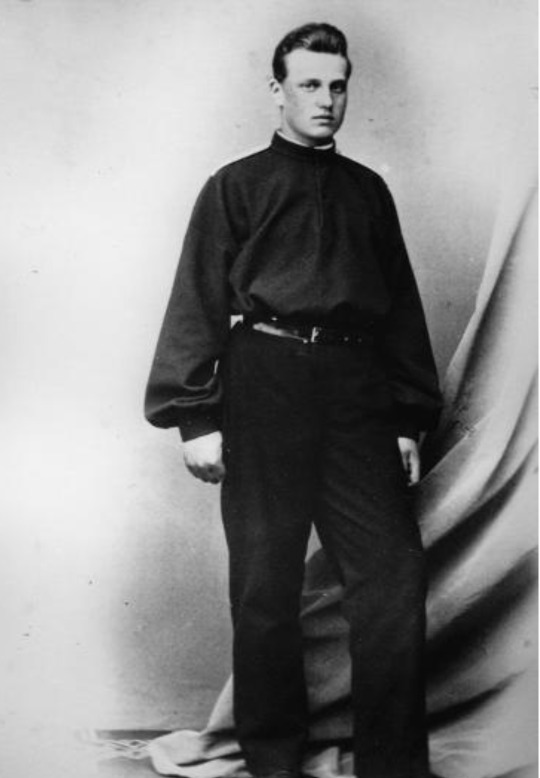

Grand Duke Alexey Alexandrovich in youth.
Grand Duke Alexey Alexandrovich (1850 - 1908)
Grand Duke Alexis was the fifth child and the fourth son of Alexander II and Empress Maria Alexandrovna. Alexis was Nicholas II's favorite uncle, as well as a favorite of Empress Maria Feodorovna (and a frequent dance partner of the Empress since Sacha did not like to dance. He also acted as a mediator between her and Sacha at the very beginning of their marriage, when they had differences.) He stood as one of Tsarevich Alexis' godparents.
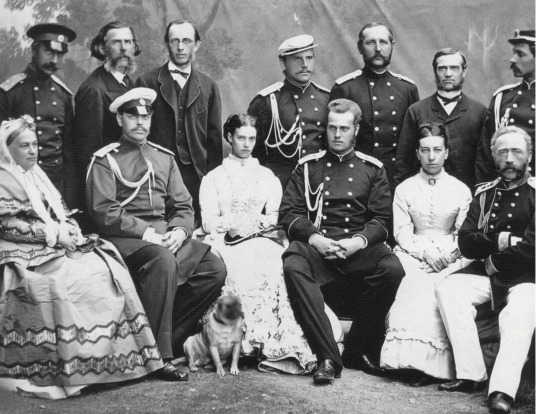

1. Maria Feodorovna sitting between Tsarevich Alexander and Grand Duke Alexis; 2. Grand Duke Alexis with his family, embracing his brother Grand Duke Sergei Alexandrovich
Alexey made a career in the Navy. Grand Duke Alexey rose through the ranks, holding many important posts. He was appointed General Admiral by his brother Alexander III as a reward for making a significant contribution to modernizing the equipment of the Russian navy. But his improvements might not have been enough. After the Russian defeat to the Japanese in the Battle of Tsushima, Alexey was relieved of his command for incompetence (he died just three years after this, at age 58.) It did not help that his expenses in jewelry for the beautiful women in his life had increased through the years, and he was suspected of corruption. He had acquired a reputation as a "man of fast women and slow ships." Of course, somebody had to pay for Russia's loss to Japan, and he was in the right place at the right time.

Admiral Grand Duke Alexei Alexandrovich
Was Alexey a hero or a rake? Neither, it seems. The following is the consensus of several authors and contemporaries who knew him well: He had a kind heart and would not intentionally hurt anybody. He was not a thief. He was not a plotter or acted against anybody for his own advancement, but he was, in fact, not very competent as an admiral and made a number of wrong decisions that had terrible consequences for the Russian naval forces.
Alexis was beloved by most of his family, although his cousin Grand Duke Alexander Mikhailovich, did not have anything good to say about him in his book "Once a Grand Duke;" Sandro paints Alexey as a hard-drinking, greedy, womanizing dilettante without any redeeming qualities. Sandro very much wanted Alexis' job and was well situated to get it; I don't know how objective he could be under those circumstances (Sandro's book is used as a source for much of what is written about the Romanovs, but inaccuracies and mistakes have been identified in the information it provides.)
Alexis suffered a broken heart early in his life. Although his affairs with beautiful women were notorious throughout his life, he is the only Grand Duke, son of a Tsar, who remained unmarried. His is a life of plenty but not a happy life.
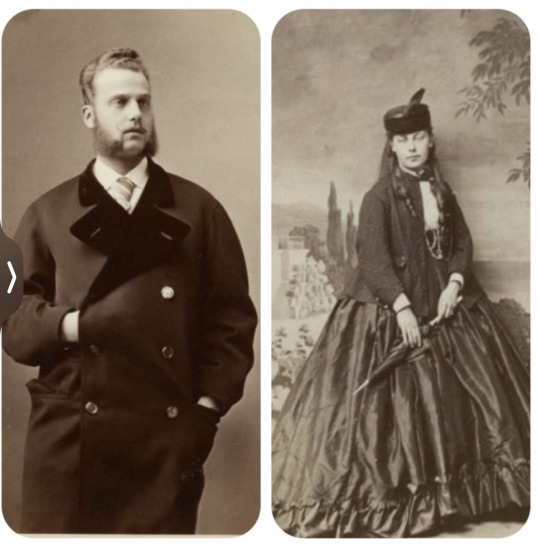
Grand Duke Alexei Alexandrovich and Alexandra Zhurovskaya
Alexei fell in love with one of his mother's ladies-in-waiting at age twenty. Her name was Alexandra Zhukovskaya; she was the daughter of a poet (who had taught the Imperial children) and not an aristocrat. Alexandra became pregnant. Alexis’s father, Alexander II, opposed the affair violently and said no when Alexis asked permission to marry. The Emperor also refused his son's request to grant the mother and unborn child a title. Some historians believe Alexey married Alexandra, and the Russian Orthodox church annulled the marriage at the Emperor's behest.

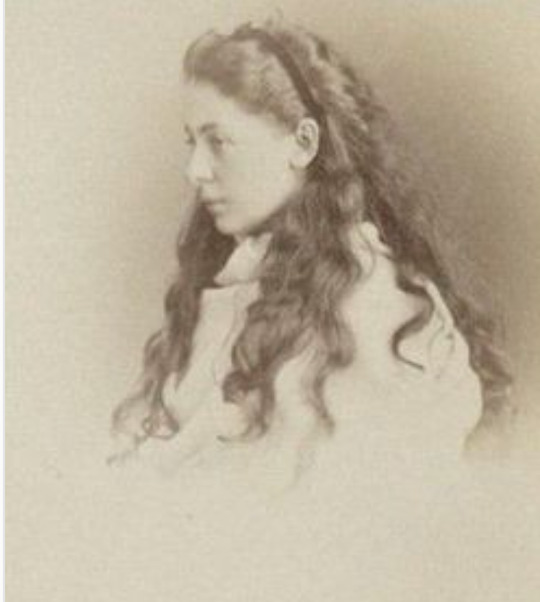
Alexandra Zuhrovskaya
There are letters in which Alexis begs his mother, Empress Maria Alexandrovna, to intercede so that he does not have to abandon Alexandra; they also declare his love for her. Alexander II sent Alexey on an extensive world tour (he was away from Russia for two years; his tour included a very successful visit to the United States.) Alexandra gave birth to their son while he was away. The Imperial family continued to put pressure on her until she terminated the relationship with Alexey. She was married off to Baron Christian-Henrich von Wohrmann and sent to live with him in Munich/Bavaria. Alexis never saw her again but did not abandon her and his son. He settled a large sum and a generous lifetime pension on Alexandra and made provisions for the future of the boy.
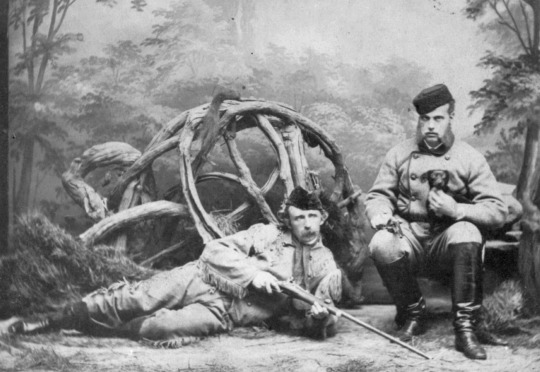
Grand Duke Alexander Alexandrovich with General Custer - the photo commemorates their "buffalo hunt."
Before her child was born, Alexandra had secured the title of Baroness Seggiano from the Republic of San Marino, with the right to pass it to her son. After Alexander II died and Alexey's elder brother was crowned Alexander III, Alexey's son was given the Russian nobiliary title of Count Belevsky and a coat of arms.


Grand Duke Alexis' son: Count Alexey Alexeevich Belevskiy-Zhukovskiy (1871–1931)
Count Alexey Alexeevich Belevskiy-Zhukovskiy (1871–1931), the Grand Duke's son followed a military career like all Romanov males. His first marriage (he married twice) took place in Ilinskoye Manor, the state of his uncle Grand Duke Sergei Alexandrovich, near Moscow. The Count acted as his uncle's aide-de-camp for many years. He was well-accepted in Imperial circles. There are several candid photos of Sergei and his wife Ella, where he can be identified (he looks more like his uncle Sergei than his father.) As far as we know, he never met his father (although I doubt that Grand Duke Sergei did not, at some point, arrange a meeting between his brother and his nephew.) Several of the Count's descendants live in New York City.
It is interesting to note that the major source of relentless opposition to Alexey's marriage to Alexandra and to the legitimization of his son was Emperor Alexander II, the same man who would have children with his much younger mistress, establishing a second family while his first wife was still alive, and who would bring that second family to live in the Winter Palace where his first wife resided and where she died. He married his second wife barely a month after Alexey's mother's death.
#russian history#romanov dynasty#imperial russia#Grand Duke Alexey Alexandrovich#Alexander III#Alexander II#Grand Duke Sergei Alexandrovich#Grand Duke Alexander Mikhailovich#Count Alexey Alexeevich Belevskiy-Zhukovskiy#Alexandra Zhukovskaya
77 notes
·
View notes
Text
no Russian emperor crowned after 1800 can introduce successful reforms. All they know is censorship, be depressed, support old crusty European monarchies, mary Germans and lie
#not you Paul you never did anything wrong and love you#alexander i#nicholas i#alexander ii#alexander iii#nicholas ii#yeah xix century russians knew like 2 names#history#tsar alexander i#romanovs#house of romanov
19 notes
·
View notes
Text
Romanovs men edit💋
my edit made by using capcut!!
i'm in love help mee😩😜
They are all so handsome, gentle and clever
#my edit#capcut edit#capcut#my first love#romanovs men#george alexandrovich#nicholas i of Russia#alexander iii#Sasha#peter the great#tsar nicholas ii#alexei nikolaevich#grand duke mikhail pavlovich#grand duke mikhail alexandrovich#alexander ii
46 notes
·
View notes
Text

On April 24, 1865 Tsesarevich Nicholas died. Eldest son of Tsar Alexander II and older brother of Tsar Alexander III, who was supposed to be Nicholas II..
In 1860, during the races in Tsarskoye Selo, Niksa fell from his horse and received a severe bruise in his back. But not wanting to seem weak and pampered, he says that he does not hurt at all. No one knows that this episode will be fatal in the fate of the young heir to the throne.
Time passes, but the pain in the back doesn’t go away and only intensifies every day. Dr. Shestov, assigned to the heir, assures that this is just rheumatism, not paying attention to the abscess on the back at the site of the bruise. Niksa is treated with baths, warming, massages and straightening, the pain from which is so strong that the heir screams and cries.
The prescribed treatment gave no improvement and Niksa suffered from headaches, weakness and back pain, Everyone seems to see Nicholas' deteriorating condition except his father, Alexander II who is sure this is just rheumatism, and his son is simply exaggerating his pain.
There was no remedy in the spas of Europe, and after participating in the Berlin maneuvers of 1864, in which Nikolai had to ride a horse, he could no longer move independently and straighten his back.
The last home of the heir was a villa in Nice, where he is being moved on the advice of European doctors. Even a board of eminent physicians find it difficult to diagnose Nexa, only when he appeared to vomit. Doctors finally make the correct diagnosis “tuberculous meningitis”.
Niksa died at the age of 21, after four hours of pain. He passed away and was surrounded at that moment by his parents, brothers, and his bride, the Danish Princess Dagmar, who didn’t leave him until his last breath.
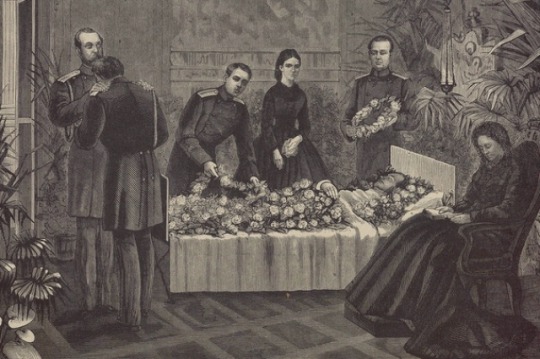
The death of the beloved Tsesarevich becomes a tragedy not only for the dynasty, but for the whole country, which passionately loved the heir to the throne.
After the death of Niska, his younger brother, Grand Duke Alexander, became Tsesarevich, and the next emperor of the Russian Empire will be Alexander III, and he will be the husband of the Danish princess Dagmar, who will be Empress Maria Feodorovna.
Alexander III will name his first son Nicholas, in honor of his beloved brother. It is this son who will become Emperor Nicholas II - the last Russian emperor.
It is difficult to say whether Nicholas Alexandrovich's life could have been longer and happier if he had been diagnosed in time and received adequate treatment. This disease was not really studied at that time, moreover, it was a very rare disease.
“Nicholas had a great future, and he was probably going to be the most educated monarch not only in Russia but also in Europe.” -Boris Chicherin

Dear Niksa on his deathbed.

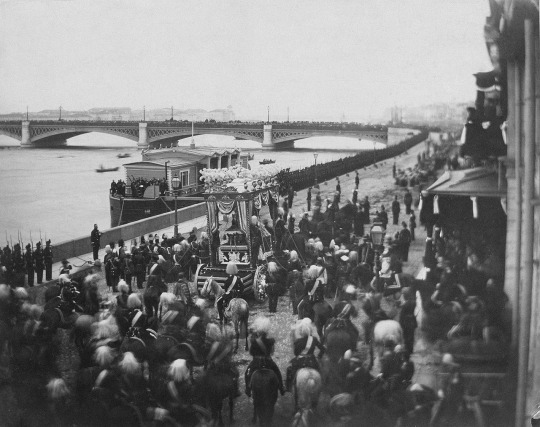
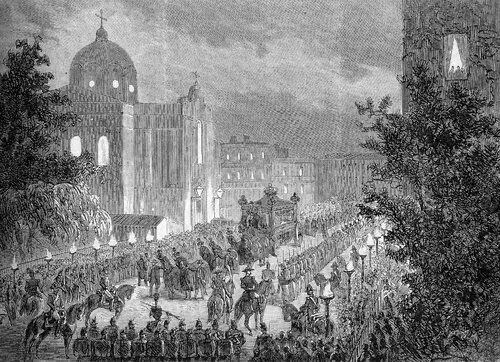
#tsesarevich nicholas#Nicholas alexandrovich#Alexander ii#alexander iii#empress maria feodorovna#1860s#1865#romanovs#russian empire
38 notes
·
View notes
Text



Tsarevich Nicholas ”Nixa” Alexandrovich, eldest son of Tsar Alexander II and heir to the Russian throne, 1843-1865.
Nixa resembled his mother, Empress Maria, more than his father both in character and appearance according to Count Sergey Dmitrievich Sheremetev, as in his memoir wrote;
”[…] Their characters were similar. Nikolai Alexandrovich looked much more like his mother, and much less that of the sovereign. He disagreed with his father in many ways and they often didn’t understand each other.”
Nixa was engaged and set to marry Princess Dagmar of Denmark but tragically passed away in France 1865 from illness. Dagmar later married in his brother Alexander, who became Alexander III.
#Tsarevich Nixa#Tsarevich Nicholas Alexandrovich#Royal History#Russian Royalty#Romanov Family#He is my favourite Romanov ;’(#Dagmar of Denmark#Alexander II
19 notes
·
View notes
Text

Emperor Alexander II of Russia.
24 notes
·
View notes
Text
Finale
Put the champaigne on ice, everyone, we are at the final step of our journey! By this time next week, we will know who is the very best Romanov, as found out by the most scientific method you could possibly use - a tumblr poll. The winner (along with a winner of every bonus poll) will be announced in a big celebratory post that will be pinned as sign that this epic competition has finally come to an end. Consider this a reminder that this week is your final chance to participate in propaganda, antipropaganda and all the other shenenigans that come with holding a monarchical poll on tumblr. This blog may end up endorsing other polls (look forward especially for our favourite weirdo Alexander I. on the Napoleonic Sexymen Tournament), but this will be effectively the very end of its active service.
As mentioned in a previous post, the two final candidates for the Best Romanov aren't fighting just for the title, but for the very definition of the term. The thing is, you can theoretically see both of them as Best Romanov, just by completely different metrics. Are we going by moral criteria, at which point we must endorse the least autocratic ruler Russia had untill... Maybe Gorbachev? Look the point is, the bar is on the ground here, and Alexander II. stepped over it.
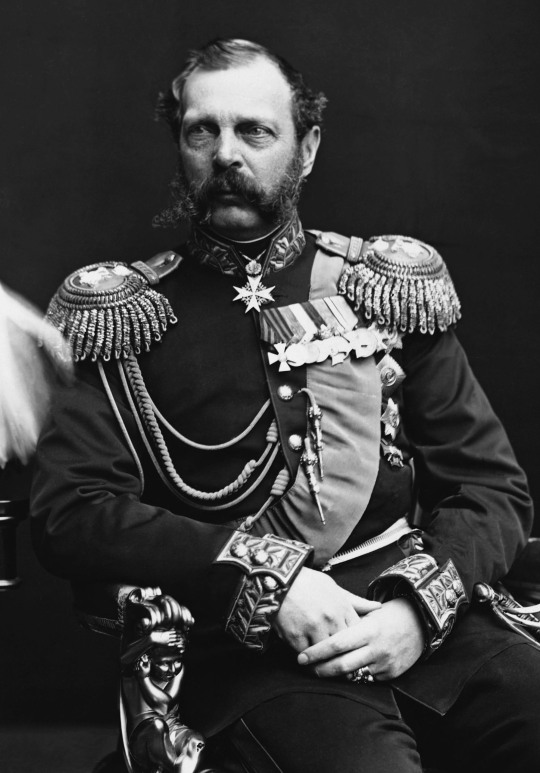
Or are we searching for a ruler that best embodied Romanov traditions of dynastic drama, autocracy, imperialism and very, very light reformism, while closing a book on the whole era of interdynastic shenenigans (Pavel I. and the dekabrists aside, because dynasty members didn't actually participate in those - at least in any capacity that we can prove) and being that quintesential Romanov creature - a toxic girlboss?

Both of these people are still well-regarded, for the most part (for a Russian monarch I mean). Both of them were incredibly sexy, as is the Romanov way. You could (and should, seriously, post propaganda, people!) make the case for both of them being deserving of the title. But there is only one crown of Monomakh and one throne (unless you're Ivan V. and Pyotr I., we guess). There can be only one victor.
So... Who *is* the best Romanov monarch, really?
11 notes
·
View notes
Text
"In the end I had to go to the bedroom where I was laid on a terrible couch. And then it all started with pain and my moaning. The emperor held one of my hands, Sasha did not let go of the other, and the empress came up from time to time and kissed me. Finally it was all over, and the cry of the baby announced the birth of our angelic son. I will never forget this happy moment in my life. I thanked the Lord for the fact that everything was over and that He gave us a son. Dear Sasha, who had been restraining himself all this time, was now sobbing like a child. And we all congratulated each other: parents, grandparents, those - us, and I thought about my beloved parents.
At 4:30 everything was over. Bazhanov came and read prayers, and my Sasha held the little one in his arms. Then Madame Mikhailova helped carry me to bed, where I immediately fell asleep. In the evening, my father-in-law came again, and, thank God, I felt completely healthy. My Sasha and I were in complete bliss!!! At 8:30 I fell asleep and woke up only at 9:30 the next day."
Maria Feodorovna on the birth of her first child, Nicholas II (May 6/18, 1868)



#maria feodorovna#nicholas ii#russia#tsar nicholas ii#czar nicholas ii#alexander iii#tsar alexander iii#czar alexander iii#the romanovs#imperial russia#history#historical couples#alexander ii#royalty#royals#baby
24 notes
·
View notes
Text
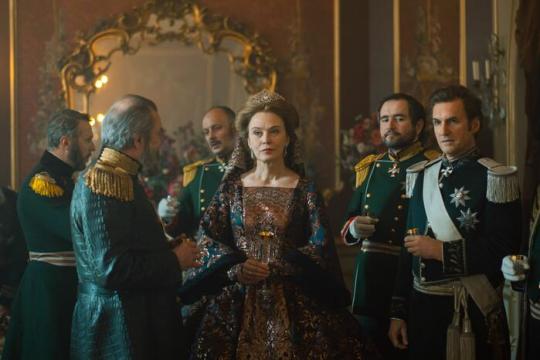
Jurij Rosstalnyi, Elita Kļaviņa and Evgenie Sokolow as Czar Alexander II, Empress Maria Alexandrovna and Siegfried Terpoorten in a new still from the third season of Sisi (2021).
#Sisi#Sisi (2021)#costume drama#historical drama#period drama#Jurij Rosstalnyi#Elita Kļaviņa#Evgenie Sokolow#Alexander II#Maria Alexandrovna#Marie of Hesse#Siegfried Terpoorten#german tv#german series#sisi.rtl#Armands Virbulis
11 notes
·
View notes
Text
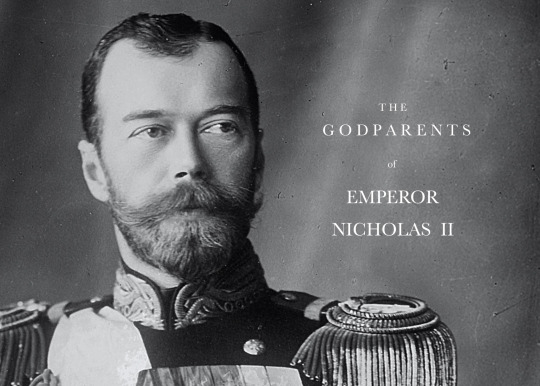


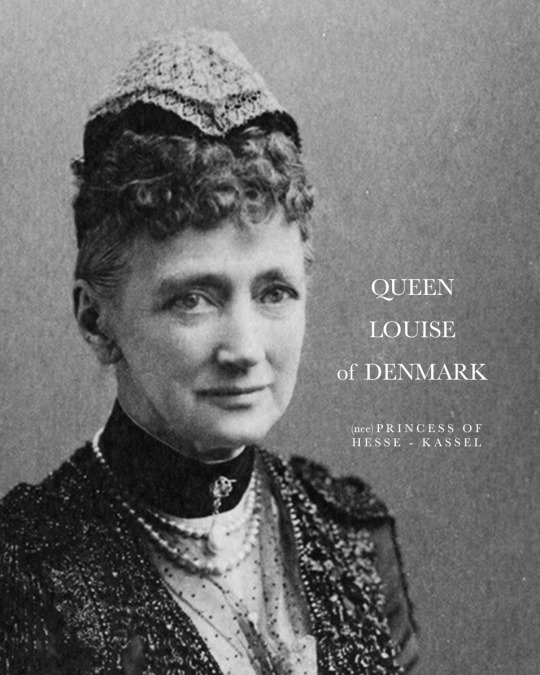

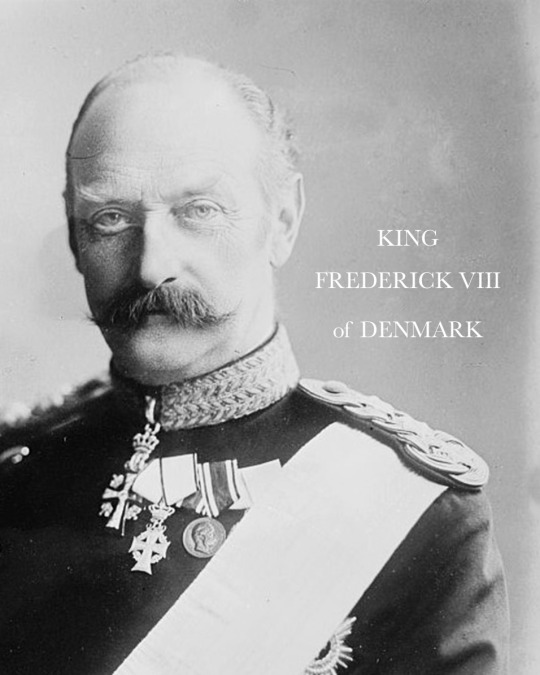
GODPARENTS OF NICHOLAS II
Born during his grandfather's reign on 18 May (New Style) 1868 at the Alexander Palace, Tsarkoe Selo in Saint Petersburg. He was the eldest son of Alexander III and his wife Maria Feodorovna (then, the Tsarevich and Tsarina of Russia). He was christened on 1 June at the Chapel of the Resurrection of the Catherine Palace at Tsarskoe Selo, by the confessor of the imperial family, protopresbyter Vasily Borisovich Bazhanov. His godparents were:
ALEXANDER II, EMPEROR OF RUSSIA - his paternal grandfather, the Russian Emperor stood as one of the godparents. He became the Emperor of All Russia in 1855. Alexander’s most significant reform as emperor was the emancipation of Russia’s serfs in 1861, for which he is known as Alexander the Liberator. He was assassinated in 1881 when the young Nicholas was only 12 years-old, to which he became the heir apparent upon his death.
PRINCESS MARIE OF HESSE AND BY RHINE, EMPRESS MARIA ALEXANDROVNA OF RUSSIA - his paternal grandmother, the consort of Emperor Alexander II, was another of his godparents. Known for her intellect, she was one of the founders of the Russian Red Cross Society. However, she suffered from tuberculosis from 1863 and spent long stays in southern Europe to avoid harsh winters. Although she and her husband were unofficially separated sometime after the death of their eldest son, Maria was treated with respect and love by her surviving family. Maria passed away from illness when the young Nicholas was still a child.
PRINCESS LOUISE OF HESSE-KASSEL, QUEEN CONSORT OF DENMARK - his maternal grandmother was listed as one of his godparents. Louise became the Queen consort of Denmark upon her husband's - King Christian IX - accession in 1863, just few years before her grandson Nicholas' birth. She, herself, was a niece of another King of Denmark (Christian VIII). The great dynastic success of Louise's six children was to a great extent a result of Louise's own ambitions - through them, she was a grandmother of not only the future Tsar of Russia (Nicholas II), but also that of King George V of the United Kingdom; King Constantine I of Greece; King Christian X of Denmark, and King Harken VII of Norway.
GRAND DUCHESS ELENA PAVLOVNA OF RUSSIA - his great-great-aunt, the wife of the late Grand Duke Michael Pavlovich, was one of his godparents. Born as Princess Charlotte of Württemberg, she became a close friend of his grandmother the Empress Maria Alexandrovna, and was known as an intellectual. She was also considered the most exceptional woman in the imperial family since Catherine the Great.
KING FREDERICK VIII OF DENMARK - then, the Crown Prince, his maternal uncle stood as one of his godparents. During the long reign of his father, he was largely excluded from influence and political power. Upon his father's death in 1906, he acceded to the throne at the advanced age of 62. In many ways, Frederick VIII was a liberal monarch who was much more favorable to the new parliamentary system introduced in 1901 than his father had been, being reform-minded and democratically inclined.
Source
84 notes
·
View notes
Photo

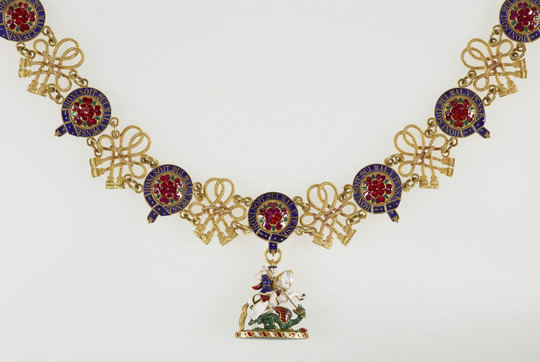
Emperor Alexander II of Russia’s investiture badge (Lesser George) of the Order of the Garter & collar and badge (Great George) of the Order of the Garter, 1867. (x)
Emperor Alexander II was invested 'with the Ensigns and Habit' of the Most Noble Order of the Garter in the Throne Room of Tsarskoe Selo on 28 July 1867 (NS). He was invested by George Henry Robert Charles, Earl Vane (later 5th Marquess of Londonderry), who had been appointed as Queen Victoria's Envoy Extraordinary to lead the Garter mission to St Petersburg.
The Earl was accompanied by the eight other members of the Mission - which included the future Duke of Marlborough, three officials of the College of Arms; Deputy Garter, Chester Herald and the Rouge Dragon Pursuivant of Arms, and Major General Lord Henry Percy and Major Christopher Charles Teesdale – both of whom had won the Victoria Cross during the Crimean War. The inclusion of two recipients of the Victoria Cross was not insignificant because part of the rationale to appoint the Emperor to the Order was to help heal the wounds of the conflict some 10 years earlier.
The insignia was supplied by Garrards. The cost of the insignia and other items, 3 silver gilt boxes, mantle, Garter Shield, seven velvet cushions with tassels (for the investiture ceremony), the silver underhabit, plume, materials for the banner in St George's Chapel, trunks for transportation, Garter ribbon and binding of the statutes came to £538-2–0.
The Mission left London on 18 July, arriving in St Petersburg on the 24th. The suite was received in Audience with the Emperor on 26 and 27 July. On the morning of the 28th they travelled in five royal state carriages with outriders and grooms in state liveries from the Alexander Palace to the Catherine Palace and were met by a guard of honour. They then processed to the Throne Room, with Major Teesdale bearing the hat, plume and star, Viscount Canterbury the collar, Lord Henry Percy the sword, the Marquess of Blandford the Mantle and cordon, George Adams (Rouge Dragon Pursuivant) the Garter, riband and George while the rest of the party carried the Queen's commission and a copy of the statutes of the Order.
The Emperor wore his Garter Insignia at the time of the marriage of his daughter Grand Duchess Marie Alexandrovna to Prince Alfred, Duke of Edinburgh, in January 1874 and during his subsequent visit to London in May that year. They were, in sadder times, to form part of the display of the Emperor's insignia at his funeral after his assassination in 1881. Following the funeral, the insignia was returned to London with the star and badge displayed at Queen Victoria's command at Windsor Castle. | The Royal Collection
50 notes
·
View notes
Text
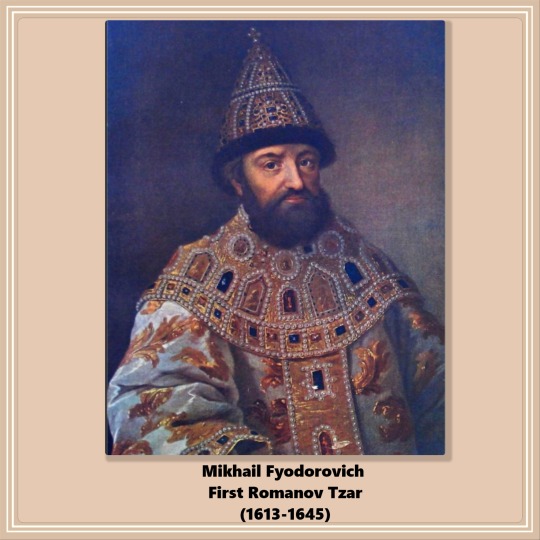






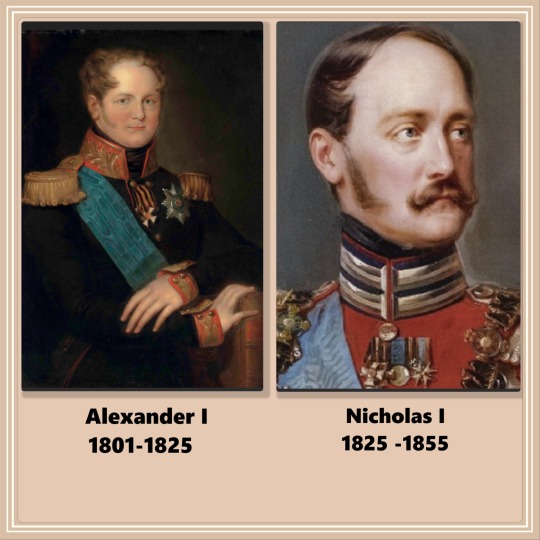

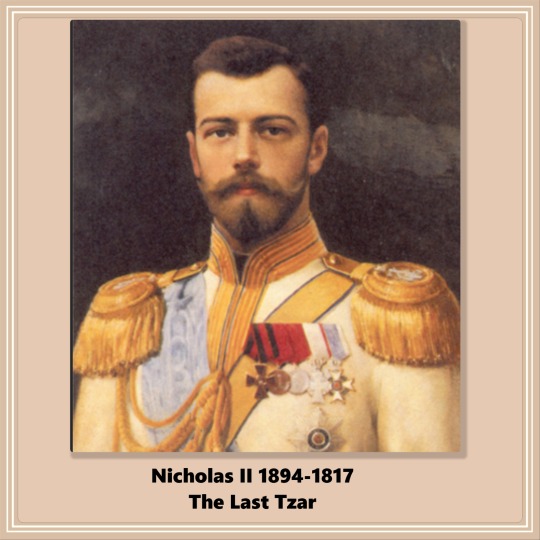
👑The Romanov Dynasty
The Grand Duchy of Moscow under Prince Ivan III was the first unified state on Russian territory. With him began the Rurikid Dynasty (the Rurikid had been around for a long time along hoards of tartars).
The Rurikid ruled from the 1400s until the 1600s. Ivan III can be considered the founder of Russia. While the Rurikid were in power, the Romanovs were boyars (nobles) in their courts. When the Ruriks became extinct, the Romanovs took over. The "Zemsky Sorbor" (a rudimentary parliament) elected Mikhail Feodorovich as the first Romanov Tzar.
The direct male line of the Romanovs ended with Elizabeth of Russia, who was childless. Her nephew Peter III, a member of the House of Holstein-Gottorp (a cadet branch of the German House of Oldenburg that reigned in Denmark), ascended to the throne and adopted his Romanov mother’s house name. Descendants after Elizabeth are sometimes referred to as "Holstein-Gottorp-Romanov."
The above is a gross oversimplification of a very complex course of events.
Highlights about each Romanov Tsar/Tsarina:
👑Mikhail Feodorovich (1613 - 1645): First Romanov Tsar
👑Alexei Mikhailovich (1645 - 1676): Encouraged trade and cooperation with Europe. Father of Peter the Great
👑Feodor III (1676 - 1682): Had very poor health and spent most of his reign in bed
👑Peter I and 👑 Ivan V (1689 - 1785): It was complicated. The two of them were Tsars under the regency of their older sister Sophia.
👑Peter I (1689-1725): Reformed Russia's politics, government, and culture. Made Russia a military power.
👑Catherine I (1725-1727): At the time of Peter the Great's death, the mechanism for succession consisted of the Tsar selecting his successor, but Peter did not elect one before dying. His wife became the Tsarina, but others governed through her.
👑Peter II (1727-1730): Peter's grandson; ascended the throne at 11 and died at 14. The "Privy Council" or "Soviet" ruled through him.
👑Anna Ioannovna (1730-1740): Daughter of Peter's half-brother Ivan. The Privy Council invited her to rule (wanting her to be a puppet), but she disbanded them and ruled herself successfully.
👑Ivan VI (1740-1741): One-year-old son of Ana's niece. She left the throne to him, expecting his mother to govern. Elizabeth, daughter of Peter the Great, deposed him (and his mother.)
👑Elizabeth Petrovna (1741-1761): Last Russian on the Russian throne; her twenty-year reign was successful.
👑Peter III (1761-1762): Grandson of Peter the Great and next in line for the throne after Elizabeth. Ruled for only half a year before being deposed by his wife, Catherine. He was murdered soon after the coup d’etat.
👑Catherine the Great (1762-1796): Her accomplishment went from the Empire’s territorial expansion to political development to the proliferation of sciences. However, the Empire had an enormous external debt by the end of her reign.
👑Paul I (1796-1801): Paul, the son of Catherine the Great and Peter III, became Emperor at 42 after the death of his mother. He started a lot of major military and political reforms. Paul was murdered in a coup d'etat. Paul decreed house laws for the Romanovs (the Pauline laws) – among the strictest in Europe – which established semi-Salic primogeniture and required Orthodox faith for the monarch and dynasts
👑Alexander I (1801-1825): During his reign, Russia defeated Napoleon's forces (which got as far as Moscow in their attempt to conquer Russia.) There was also great development in culture and arts.
👑Nicholas I (1825-1855): Paul I’s third son, younger brother of Alexander. Started railroad construction in Russia, boosting industrialization. Codified Russian laws and reformed finances.
👑Alexander II (1855-1881): His major reforms included the peasant emancipation of 1861, military reform, and the introduction of new types of self-governing village societies and more. Unfortunately, he fell victim to a terrorist after five attempts.
👑Alexander III (1881-1894): Russia didn’t enter any wars in his time. His domestic policy was conservative. He amended the Pauline laws. The economy flourished. But the revolution was brewing below the surface.
👑Nicholas II (1894-1917): His policies were unsuccessful. Established the first official Duma in 1905, but it was too little too late. With the advent of WWI, the Russian Empire ceased to exist. He abdicated. (gcl)
Sources:
Panov, A., Delaroche, P., & Abramuchkin, Y. (2021, July 31). The Complete List of Russian Tsars, Emperors, and Presidents. Russia Beyond. Retrieved June 20, 2023, from https://www.rbth.com/history/334065-complete-list-of-russian-tsars-emperors-rulers-presidents
#russian history#imperial russia#romanov dynasty#Nicholas II#Alexander III#Alexander II#Alexander I#Catherine I#Catherine II#Nicholas I#Paul III#Elizabeth Petrovna#Mikhail Feodorovich#Alexei Mikhailovich#Feodor III#Ivan VI#Peter I#Peter II#Peter III#Anna Ioannovna#Romanov Tsars#gcl
23 notes
·
View notes
Text
All that said, we should be worried as much by the prospect of Putin’s defeat as by any victory. What if Putin were toppled? This is not like the last days of the Soviet Union. There is no nice, decent Yeltsin-like or Gorbachev-like figure with the power and standing to immediately take over.
“The old Soviet Union had institutions — there were party and state organs — central and provincial — which were responsible for maintaining their bailiwicks, as well as some order of succession,” Leon Aron, a Russia scholar at the American Enterprise Institute, whose book about Putin’s Russia is being published in October, remarked to me. “When Putin came in, he bulldozed or subverted all political and social structures outside the Kremlin.”
But Russian history does offer some surprising twists, Aron added: “Longer-term, historically, successors to Russia’s reactionary rulers are often more liberal, especially early in their term: Alexander I after Paul I, Alexander II after Nicholas I, Khrushchev after Stalin, Gorbachev after Andropov. So if we can get through a transition from Putin, there is some hope.”
In the near-term, though, if Putin were to be ousted, we could well end up with someone worse. How would you feel if Prigozhin were in the Kremlin this morning, commanding Russia’s nuclear arsenal?
You could also get disorder or civil war and the crackup of Russia into warlord/oligarch fiefs. As much as I detest Putin, I detest disorder even more, because when a big state cracks apart it is very hard to put it back together. The nuclear weapons and criminality that could spill out of a disintegrated Russia would change the world.
This is not a defense of Putin. It is an expression of rage at what he did to his country, making it into a ticking time bomb spread across 11 time zones. Putin has taken the whole world hostage.
If he wins, the Russian people lose. But if he loses and his successor is disorder, the whole world loses.
#current events#history#politics#russian politics#russo-ukrainian war#2022 russian invasion of ukraine#ussr#russia#yevgeny prigozhin#vladimir putin#alexander i#paul i#alexander ii#nicholas i#nikita khrushchev#josef stalin#mikhail gorbachev#yuri andropov#wagner group
3 notes
·
View notes
Text
Happy Birthday to Tsar Alexandar II Nikolaevich Romanov! (29th April)
Love you Sasha🤍




10 notes
·
View notes